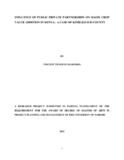| dc.description.abstract | Food security and especially maize production and distribution as Kenya’s staple food
have of late been declining. This has become a pertinent issue for the survival of a country’s
increasing population and urban settlement population and in particular within the Kimilili Subcounty despite the fact the Kimilili area is well endowed with good climatic conditions. Many
maize farmers, in Kimilili sub-county, sell their maize immediately after harvesting them only to
purchase it back later in the season when their own saved stocks have been consumed. Maize
value addition (production, processing and distribution) in Kimilili sub-county does not only
provide food security to the population, it is also a source of livelihood to about 60% of the
population in Kimilili sub-county in form of employment generation. This research endeavoured
to assess the influence of government engagement with relevant private stakeholders in form of
Public private partnership (PPP’s) in maize value addition to meet the population food security
needs and increase chances of business and livelihood creation among the local people in
Kimilili sub-county. The study sought to investigate the influence of PPPs (Financing support
services, Market Information and Intelligence, Communication systems, Extension, Research
and Development, Infrastructure development, Government policy and Regulations) on maize
value chain in Kimilili sub-county. A questionnaire with closed ended questions was prepared
and distributed to respondents in all the wards and collected after one week. The return rate was
96%. The study adopted a descriptive survey design and stratified sampling in its research. The
Yamane formula was used to get a sample size of 202 respondents. Questionnaires and interview
schedules were used to collect data. Descriptive statistics such as mean, frequencies and
percentages were used to compute and summarize data, which was then presented in the form of
frequency tables and percentage. The findings revealed that financing in maize crop value chain
happens at all stages of value addition. The study showed that traders dominate the maize crop
market channel right from farm gate. The study also showed that more farmers accessed either
research and extension services in maize crop value chain. The findings showed that underdevelopment of key infrastructure facilities has limited value addition of maize crop in Kimilili
sub-county. It was concluded that farmers preferred financing at input supply and production
stage in maize crop value chain, less effort has been taken by farmers to market their produce
directly to consumers and institutions of higher learning, extension and research services
provided to farmers in maize crop value addition are more inclined towards input supply
services. The green maize was in high demand in Kimilili sub-county during off-peak seasons.
The study generated opportunities for sustainable partnership engagement to improve the maize
value chain in Kimilili sub-county. | en_US |

